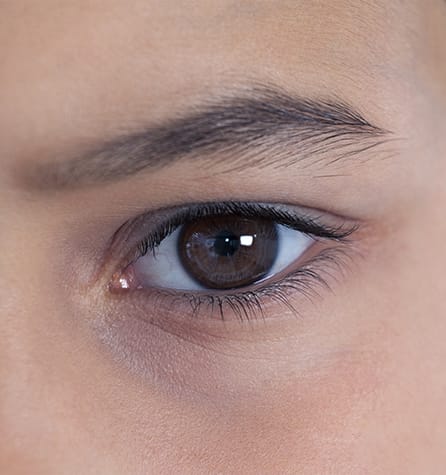Healthier Vision Through Routine Eye Care
The first step towards detecting and managing eye disease is a routine eye exam. Our optometrists scan for common diseases during every comprehensive exam and can help provide treatment for many different conditions.
Eye disease can develop without warning signs or symptoms, so we use top-of-the-line diagnostic equipment to catch eye conditions in their early stages. You can trust that our team works hard to provide proper treatment and protect your vision.
We want to protect your sight and keep your eyes healthy for many years to come. Please contact us today for your next eye exam!
Common Eye Conditions & Diseases
Age-Related Macular Degeneration
The macula is the central part of the retina, and its primary function is providing clear, sharp detail in your central field of vision. Age-related macular degeneration occurs when the macula breaks down through the aging process.
When the macula deteriorates, it results in blurry central vision, the loss of ability to see precise detail, and fading color vision.
There are two variations of AMD:
- Dry AMD: This condition occurs slowly as the macula thins over time, causing vision issues.
- Wet AMD: This condition occurs more quickly than dry AMD, and causes approximately 90% of AMD-related blindness. Wet AMD develops when abnormal blood vessels form underneath the retina, resulting in a leakage of fluid from the macula. Wet AMD requires immediate medical care.
Cataracts
Cataracts are a normal part of the aging process. Cataracts can “cloud” your eye’s ordinarily transparent lens as they become more solid and opaque with age. This clouding can severely impact your vision.
Cataracts are the leading cause of blindness globally, and some patients with diabetes have a higher risk of developing cataracts at a younger age.
Cataracts have many symptoms, such as:
- Cloudy vision
- Blurry vision
- Dimmed vision
- Worsening of night vision
- Light sensitivity
- Sensitivity to glare
- Needing brighter lights for reading
- “Halos” around lights
- Fading or yellowing color vision
In the early stages, your optometrist may prescribe glasses or contact lenses for refractive errors; but only surgery can remove cataracts from your eyes.
Glaucoma
Glaucoma is a group of diseases that progressively damage your optic nerve. It is often referred to as “the silent thief of sight” because of how slowly it can develop. Many patients don’t experience any symptoms until the advanced stages.
Glaucoma typically affects older people, but there have been instances of its occurrence in younger age groups. If glaucoma is left untreated, it can eventually lead to vision loss.
Symptoms of glaucoma vary depending on the type and stage of the condition.
Signs to watch for include:
-
- Patchy blind spots in your vision, frequently in both eyes
- Tunnel vision in later stages
- Severe and sudden headaches
- Eye pain
- Nausea and vomiting
- Blurred vision
- “Halos” around lights
- Redness in the eyes
Your routine comprehensive eye exam is the best defense against glaucoma. Optometrists cannot reverse vision loss caused by glaucoma, but they can slow the onset and prevent further damage if the condition is caught in its early stages.
Keratoconus
The cornea should be shaped like a dome, but in some cases, it can slowly start to thin and take on a cone shape. This condition is called keratoconus. Keratoconus develops gradually, and its onset generally begins between the ages of 10 and 25.
Symptoms of keratoconus include:
- Visual distortion
- Light sensitivity
- Issues wearing contact lenses
- Sudden worsening of vision
- Frequent desire to change eyeglass prescriptions
Your optometrist may treat the initial symptoms of keratoconus with scleral contact lenses and eyeglasses. As the condition progresses, your optometrist may recommend a cornea transplant.
Conjunctivitis
You may recognize conjunctivitis by its notorious nickname, pink eye! Conjunctivitis is an infection of the transparent membrane that lines your inner eyelids and eyes. The inflamed vessels cause the eye to appear red or pink.
Bacterial or viral infections generally cause conjunctivitis, and it is very easily transmitted (Ask any elementary school teacher!) The recommended treatment will be affected by which type of conjunctivitis you’ve contracted.
Contact Griffin Optometric Group – Talega if anyone in your family develops these symptoms:
- Redness or pinkness in one or both eyes
- Itchiness in one or both eyes
- Gritty feelings in one or both eyes
- Discharge in one or both eyes that forms a crust during the night
- Tearing


An Experienced Team At Your Side
Being diagnosed with eye disease can be life-changing, but our compassionate team is here to walk you through the next steps and provide treatment. We’ll do everything we can to help ensure your vision stays as healthy as possible. We’re in your corner!
We provide individualized treatment plans to help manage symptoms and preserve your eyesight. If you have concerns about your vision or want more information about eye diseases, call us to book your appointment.
Come See What We’re All About
Here We Are
You’ll find us in the Courtyards At Talega, on the corner by Starbucks.
Where to Park?
There’s lots of parking out front for everyone!
Our Address
- 1001 Avenida Pico #A
- San Clemente, CA 92673
Contact Information
Hours of Operation
- Monday: 8:00 AM – 5:00 PM
- Tuesday: 8:00 AM – 5:00 PM
- Wednesday: 8:00 AM – 5:00 PM
- Thursday: 8:00 AM – 5:00 PM
- Friday: 8:00 AM – 5:00 PM
- Saturday: Available by Appointment
- Sunday: Closed
Our Eye Care Services

Adult & Senior Eye Exams

Children’s Eye Exams

Contact Lens Exams, Fittings, & Brands

Eye Disease Diagnosis & Management
Our Brands




Our Google Reviews
Be the First to Know,
Be the First to Win.
From eye health insights to exclusive giveaways, your feed just got a lot clearer.



